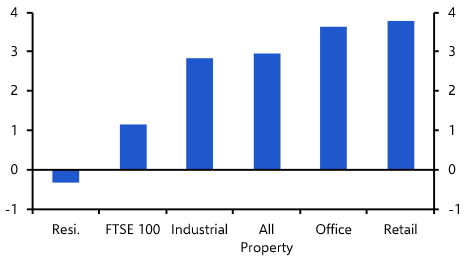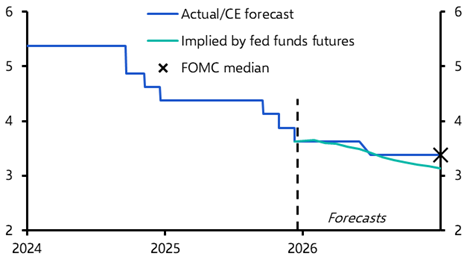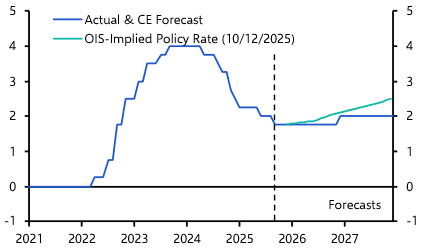Some of the most thoughtful end-of-year pieces that have been published over the past couple of months have considered why economists failed to foresee the current surge in inflation. It’s something we’ve been thinking about too. After all, while we thought that inflation would rise more quickly than the consensus expected at the start of last year, it ultimately increased far faster than even we had anticipated. Understanding why this happened helps us to get a handle on what might come next and improve forecasts in the future.
Part of the answer lies in what’s happened in global commodity markets. Higher energy prices accounted for about six-tenths of the rise in headline inflation in advanced economies last year. At the start of the year, we forecast that Brent oil would rise from $48pb at the time to $60pb by the end of 2021. That put us well above the consensus but, in the event, Brent rose to over $80pb. Natural gas prices rose by more. Part of the reason was that oil supply (particularly in the US) was slower to respond than we had anticipated. US production is now increasing, which is one reason why we expect oil prices to drop back a bit this year. But the scale of the jump in global energy prices last year was a key reason for the inflation surprise.
However, it’s not just an energy story. Core inflation, which strips out energy and food items, also jumped from 1% in advanced economies at the start of the year to over 3% by the end of it. (See Chart 1.) This is difficult to fully explain using the framework of demand, capacity and output gaps that’s taught in Economics 101. After all, the experience of the past 25 years suggests that these rates of core inflation should only occur in advanced economies that are overheating to a significant extent. And there’s no compelling evidence to suggest that economies are hotter now than they were at, say, the peak of the housing bubble in 2007 when core inflation was much lower.
Chart 1: Core Inflation in Major Advanced Economies (%, latest = Nov.)

Sources: Refinitiv, Capital Economics
Instead, the surge in core inflation is better explained by looking at what’s happened to relative prices. Core goods inflation in advanced economies has surged to almost 7% y/y, compared to an average of just 0.7% since 2015. In contrast, services inflation in advanced economies is currently running at 2.7% – only a bit above the average of just over 2% since 2015.
Chart 2: Core Goods & Services CPI Inflation in Major Advanced Economies

Sources: Refinitiv, Capital Economics
This divergence reflects the huge surge in consumer demand for goods during lockdowns (particularly in the US), and the fact that, in the short term at least, the production of those goods is relatively inelastic. Higher goods demand has led to higher goods prices.
Chart 3: G7 Real Goods & Services Consumption (Q4 2019 = 100, latest = Q3)

Sources: Refinitiv, Capital Economics
We would not normally expect shifts in spending habits to affect headline inflation to such a large extent. This is because, for a given level of income, a rise in demand (and prices) in one area should be offset by a fall in demand (and prices) in another.
But that hasn’t happened for two reasons. The first is that prices are sticky on the downside (so services prices haven’t fallen to offset the rise in goods prices). The second is that huge fiscal transfers mean that incomes have risen, particularly in the US. Jason Furman, the Head of the Council of Economic Advisors under President Obama, makes the interesting case that the rise in inflation reflects the fact that governments had lost faith in the ability of fiscal policy to influence income, output and prices, and therefore overdid the scale of stimulus.
Viewed this way, the surge in inflation has been driven by a combination of factors: a larger-than-expected rebound in global energy prices, big shifts in the composition of consumer spending that have pushed up goods prices, and fiscal support that, in the US at least, was excessive.
So what comes next? Even if global oil and gas prices stay flat at their current high levels, fading base effects mean that energy inflation will fall back, knocking 1.5%-pts off headline inflation in advanced economies. Similarly, goods inflation won’t be sustained at these rates without another surge in demand and/or incomes.
The key is what happens to services inflation. As Chart 2 shows, it has started to pick up in recent months. The question is whether this is a temporary increase driven by pandemic-related frictions and labour mismatches that will ease over time, or whether it is the start of something more permanent driven by excessive demand and the much-feared wage-price spiral. That’s a question I’ll tackle next week.
In case you missed it:
- Our US team set out what to expect from this week’s FOMC meeting.
- We have published several Outlooks over the past week, containing updated forecasts and analysis of the economic outlook for countries and regions. This includes for the UK, US, euro-zone and Latin America.
- Finally, a last call for our “World in 2022” page, which outlines how we think economies and markets will perform this year.




